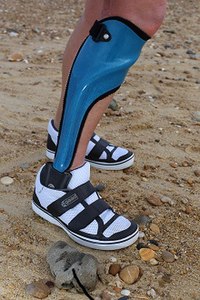
Photo from wikipedia
Maintenance and improvement of neuromuscular functions is crucial for everyone regardless of age. An easy way to assess neuromuscular properties without muscle contraction is useful especially for those who cannot… Click to show full abstract
Maintenance and improvement of neuromuscular functions is crucial for everyone regardless of age. An easy way to assess neuromuscular properties without muscle contraction is useful especially for those who cannot perform strenuous muscular force production, such as older adults and patients with orthopedic or cognitive disorders. Bioelectrical impedance analysis (BIA) can assess body electrical properties e.g., phase angle (PhA) which is regarded as muscle quantity/quality index. The purpose of this study was to investigate associations of PhA with neuromuscular properties of the knee extensors in 55 young (n = 23) and older (n = 32) adults. The values of PhA of the right thigh and whole-body were determined with BIA at 50 kHz. The participants performed 4-s maximal voluntary isometric contraction (MVIC) to measure peak torque (PTMVIC), and 1-s brief MVIC to assess rate of torque development (RTD) over the time interval of 0–200 ms. As markers of physiological mechanisms of muscle force production, twitch contractile properties (peak twitch torque, rate of twitch torque development, and time-to-peak twitch torque) of the knee extensors obtained by femoral nerve electrical stimulation, and muscle activity assessed as root mean square values of electromyographic activity (EMG-RMS) during PTMVIC and RTD measurements were measured. Thigh and whole-body PhA significantly correlated with PTMVIC (r ≥ 0.555, p < 0.001) and electrically evoked twitch parameters (peak twitch torque, rate of twitch torque development, and time-to-peak twitch torque; |r| ≥ 0.420, p ≤ 0.001), but not RTD (r ≤ 0.237, p ≥ 0.081) or EMG-RMSs (|r| ≤ 0.214, p ≥ 0.117). Stepwise multiple linear regression analysis revealed that thigh PhA was selected as a significant variable to predict PTMVIC but not RTD. Whole-body PhA was not selected as a significant variable to predict PTMVIC or RTD. In conclusion, both thigh and whole-body PhA can associate with maximal voluntary muscle strength of the knee extensors, and this association may be due to intrinsic contractile properties but not neural aspects. Regarding prediction of the knee extensor strength, thigh PhA is preferable as the predictor rather than whole-body PhA which is used as a widely acknowledged indicator of sarcopenia.
Journal Title: Frontiers in Physiology
Year Published: 2022
Link to full text (if available)
Share on Social Media: Sign Up to like & get
recommendations!